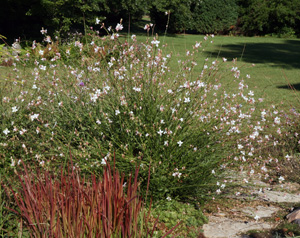
Gaura was a genus of about 20 species in the evening primrose family (Onagraceae), but as a common name generally refers to Gaura lindheimeri. (Taxonomic research in the early 2000’s moved this and other Gaura species into the genus Oenothera, so the plant becomes Oenothera lindheimeri, although that name change has not been adopted in the horticultural industry).
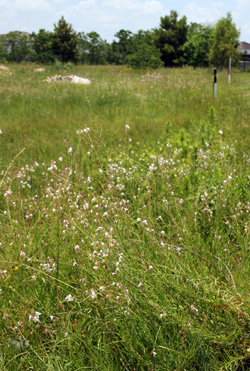
This nearly shrubby herbaceous perennial native to southeastern Texas, Louisiana, and Mexico has become more popular as a garden plant with the introduction of more compact cultivars. Other occasionally used common names include appleblossom grass, bee blossom, wand flower, or white gaura. This species is hardy in zones 5-9 and was awarded the Royal Horticultural Society’s Award of Garden Merit.
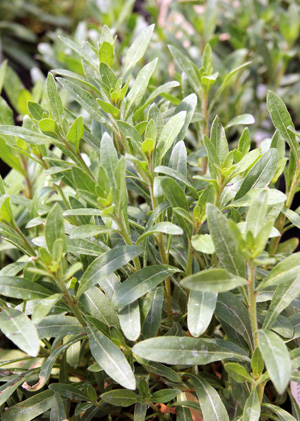
The plant form is a basal clump of leaves from a woody tap root. The narrow, lance-shaped leaves are entire or faintly and irregularly toothed. Leaves may be wavy and some are spotted with maroon. The foliage varies in color from dark green to burgundy. The foliage dies back to the ground in the winter (except in mild climates where it is evergreen) and growth may be slow to emerge in spring. Although it is a perennial, individual plants may not be long-lived.

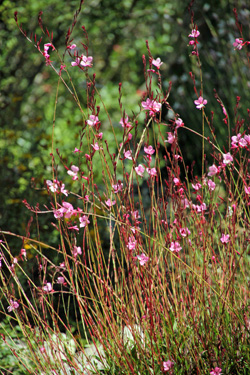
Gaura starts blooming in early summer, producing long, branched, wiry flower stems that continue to elongate throughout the extended blooming period until hard frost.
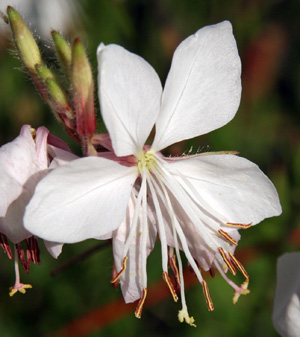
The graceful flower stems grow 3 to 4 feet tall, with clusters of small flowers opening sequentially along the open terminal panicles. Pink buds open to white flowers which slowly fade to pink. Each ½ to 1 inch wide flower has four petals surrounding eight long yellow stamens, with all the petals directed somewhat upwards. Flowers of the species are white or pink tinged but named cultivars may have more intensely colored petals.

Flowers are readily visited by many types of long-tongue bees and bumblebees, and may also attract butterflies.

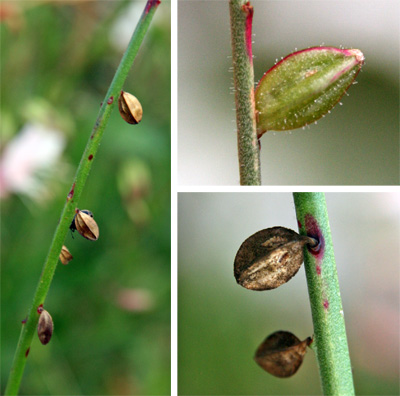
After blooming the flowers drop off, leaving a clean stalk. The fruit is an angular indehiscent nut-like body containing reddish-brown seeds. The fruits start off green, then change to dark greyish-brown when they are mature.
Some cultivars include:
- Ballerina™ series – very compact hybrids at only 12-18 inches, producing lots of flowers on the well-branched plants that spread up to 3 feet wide. Includes White, Blush, and Rose cultivars.
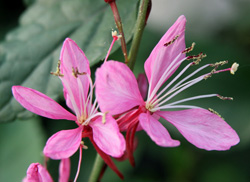
Ballerina™ Rose flowers.
They do not produce viable seed. - Belleza – this series has an upright habit, spreading to 2 feet across, with the exception of compact, mounding Compact Light Pink which is only 10-16 inches tall and 16-20 inches wide. The series includes Compact Light Pink, Dark Pink, White Evolution, all of which are listed as zone 6a.
-
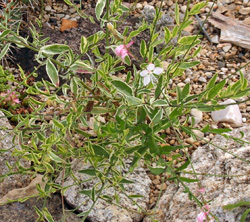
‘Corries Gold’ plant.
‘Butterflies’ series– was developed in Australia out of ‘Siskiyou Pink’. Includes ‘Crimson Butterflies’, ‘Blushing Butterflies’, and ‘Sunny Butterflies’. - ‘Corrie’s Gold’ – has variegated foliage with a creamy yellow margin on the leaves. It is not as vigorous as other types, growing only 18 inches tall and has white flowers tinged with pink.
- ‘Dauphine’ – is extra large, growing 5-7 feet tall, with green foliage and white to pink flowers.
-
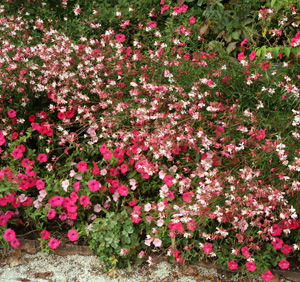
Gaura ‘Dauphine’ planted with petunias.
Karalee® Petite Pink (‘Star Pink’) – is a shorter cultivar with deep pink flowers growing only 2 feet tall. - ‘Passionate Pink’ – grows to 30 inches tall and 18″ wide, with hot pink flowers. Zone 5a.
- ‘Passionate Rainbow’ – has pink flowers and dark variegated foliage edged in pink, cream and gold. Zone 7.
- ‘Pretty in Pink’ – has dark pink flowers.
-
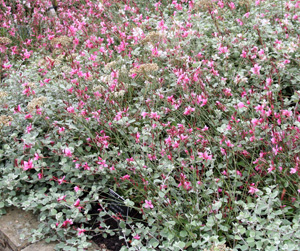
Gaura ‘Siskyou Pink’ and Helichrysum petiolare.
‘Siskiyou Pink’ – is a tall variety (2½ -3 feet) with bright pink flowers introduced in 1994 by Siskiyou Rare Plant Nursery in Medford, Oregon. Supposedly does not self-seed. - ‘Snowstorm’ – was released by the University of Minnesota in 2007, but is only rated as zone 6.
- ‘Whirling Butterflies’ – is very heavy-blooming with large white flowers on 2 foot tall plants.

The open form of the species is good in cottage gardens, wildflower meadows, and naturalistic plantings, while the dwarf cultivars are more appropriate for sunny beds and borders. With its loose sprays of flowers and airy appearance for a ‘see through’ effect, gaura fills in well between other plants and provides movement as the flowers sway in the breeze, hovering like butterflies. The taller types may be a little too “untidy” looking for very formal gardens but it generally mixes well with most styles. Its loose form provides
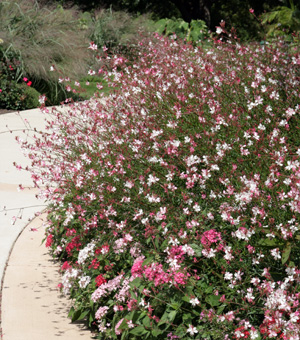
a nice contrast to tall straight plants and the fine texture contrasts well with large leaved plants. It can be used as a specimen growing above a low groundcover or planted in masses. Compact cultivars make good edging plants.
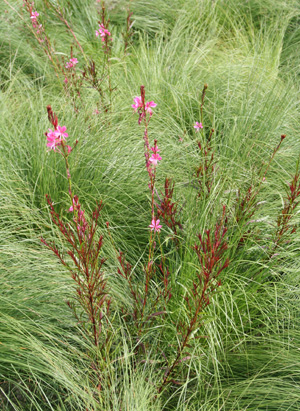
Combine gaura in prairie-style plantings with black or brown-eyed Susans, purple coneflower, asters and native grasses, or in beds with ornamental grasses, pink roses, Russian sage (Perovskia atriplicifolia) and Verbena bonariensis. Use the smaller cultivars alone or in combinations for upright form in containers.
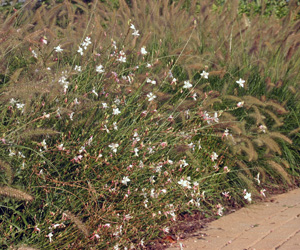
They combine nicely with silver, purple and blue foliage or flowers. Gaura can be used as a seasonal planting (especially in colder winter regions where it will not overwinter reliably), mixing well with other annuals such as petunias and pentas. It is a good choice for xeriscapes as long as the soil is well-prepared.
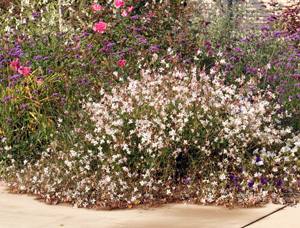
Grow gaura in full sun. It prefers light soils but tolerates clay, as long as it is well-drained. Gaura is well adapted to hot summers. Once established it tolerates drought, although adequate moisture will promote better flowering. Water and fertilize sparingly to promote compact growth and more flowers. The flower stems may become leggy and flop if grown in rich soils or too much shade. Plants can be sheared in late spring, removing up to half the height of the plant, to keep plants smaller.
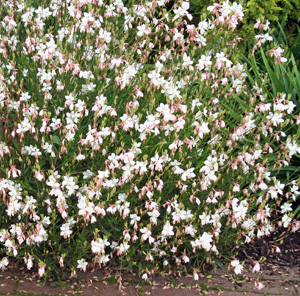
Although deadheading is not necessary, removing some of the flower stems will keep the plant looking more tidy, encourage more blooms and reduce self seeding. If all the flower spikes are cut back at once, it will take 2 to 3 weeks for the plants to start blooming again. Cut back the flower spikes in fall and remove all dead foliage the following spring.
Guara has few insect or disease problems. Root rot may be an issue in heavy, poorly drained soils.

Leaf spots, rust and mildews occasionally affect plants. It is not favored by deer. Gaura is one of many host plants of the caterpillars of the white-lined sphinx moth.

The species and some cultivars are easily propagated by seed sown in spring or fall, and can also be propagated by division in spring (a challenge with the large root) or from basal cuttings taken in summer. Many cultivars are vegetatively propagated only. Plants can bloom the first year from seed if started in early spring. It will also readily self-sow in favorable conditions and may naturalize in some areas.
– Susan Mahr, University of Wisconsin – Madison





 ▶︎ Watch: Hydrangeas: Know Them and Grow Them
▶︎ Watch: Hydrangeas: Know Them and Grow Them ▶︎ Watch: Fall Bulb Planting
▶︎ Watch: Fall Bulb Planting Aster, Symphyotrichum spp.
Aster, Symphyotrichum spp. Fascinating Fasciation
Fascinating Fasciation


